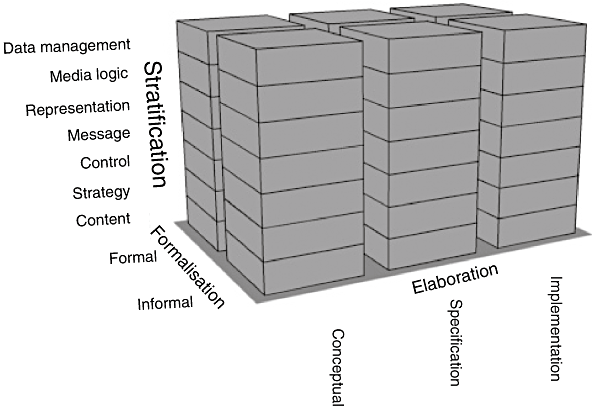Developing design documents (3D) model
Definition
The Developing design documents (3D) model is a framework to discuss and improve various kinds of instructional design languages and documents.
“Designers and producers of instructional materials lack a common design language. As a result, producers have difficulties translating design documents into technical specifications. The 3D-model is introduced to improve the stratification, elaboration and formalisation of design documents.” (Boot et al. 2007: 917).
Introduction
Boot (2005:26) argues that “production-related information is typically embedded in three types of building blocks for the production process: (a) design documents as input, (b) programming structures as throughput, and (c) learning materials as output.”
This "3D" model includes three major dimensions:
- stratification: Functionally different instructional and technical structures
- degree of elaboration: conceptual, specification or implementation
- formality: formal vs. informal

The model's dimensions
Let's examine each of the three dimentions:
Stratification
According to Gibbons, Each instructional design layer can be the defined by:
- A specific set of design goals or problems
- Sets of layer-specific design structures, expressed in the terms of design languages
- Principles for the selection, arrangement, and mapping of structures within a layer
- Principles for the relation of structures across layers
Gibbons (2000) argues that instructional designs are layered structures and also points out that layering is a general design principle. The 3D developing design documents model integrates Gibbons 7 layers:
- Content layer
- Strategy layer
- Control layer
- Message layer
- Representation layer
- Media Logic layer
- Management layer
The following table slightly adapted and Boot et al. (2007) and supplementary information from from Gibbons (2003) summmarizes objectives and constructs for each layer. The initial 2003 framework was very much inspired by typical instructional systems design and design of interactive educational media. The 2007 version included a more recent learning design view, but the model still should adapted a bit to include a more cognitive tools approach Daniel K. Schneider believes. Also it is not very clear how to distinguish between media-logic and data management for systems that would support designs like IMS Learning Design or LAMS.
| Layer | Objective | Examples of activities | Examples of design outcomes |
|---|---|---|---|
| 1. Content | Define the content and structure of the domain (learning goals in terms of know how and know that) | Task analysis, content analysis, concept mapping, model analysis | Task hierarchies, mental model descriptions |
| 2. Strategy | Define the instructional design (how should be learned) | Identification of a global instructional design model, definition of and sequencing of learning tasks, definition of social relationships during instruction, definition and sequence of time-event structures, definition of roles, goals and initiative-sharing during instruction | Task classes, case descriptions, feedback mechanisms |
| 3. Control | Define the ways a learner with the system, i.e. his "command language" | Identification of user actions, definition of control space, flow planning | Content controls, strategy controls, administrative controls |
| 4. Message | Define the message design (what should be sensed) | Definitions of message structure, composition of elements and rules | Message standards design for content |
| 5. Representation | Define the representation design (how should it be shown) | Media selection, selection of production tools and methods | Layout standards, media channel assignment, media synchronisation methods |
| 6. Media-logic | Define the software architecture (how should the programme be structured) | Definition of logic structure, algorithms creation, learning objects definition | Modularity plan, Packaging method, software platform selection, maintenance plan |
| 7. Data management | Define the data management (how should information, captured during instruction, be organised, analysed, stored and reported). | Defining administration processes, data base selection, definition of data items, capture, filtering, storage, analysis, interpretation, compilation and sharing | Security plan, billing methods, metadata assignment |
A similar, but simpler overall framework can be found in Paquette's MISA model who distinguishes between: Design of Content, Design of Pedagogical specifications, Design of Materials and Design of Delivery.
Elaboration
Boot (2005:27) adopts Fowler's three perspectives for which different levels of detail can be specified.
- A conceptual perspective, with more or less superficial and descriptive information;
- a specification perspective, with more or less comprehensive and detailed information,
- an implementation perspective with more or less technical and meticulous information
This view extends the usual 2 stage models of earlier systems design, i.e. modeling reality and then modeling the same from a pedagogical perspective.
See also: UML, todays most popular modeling framework in ICT.
Formalization
Designers can choose to use formal design languages or not.
- formal
- informal
Links
- Layered View of Instructional Designs (A. Gibbons).
References
- Boot, Eddy (2005), Building-block solutions for developing instructional software, PhD Dissertation, Open Universiteit Nederland. PDF and PDF
- Boot, Eddy W.; Jon Nelson, Jeroen J.G. van Merriënboer, Andrew S. Gibbons (2007). Stratification, elaboration and formalisation of design documents: Effects on the production of instructional materials, British Journal of Educational Technology 38 (5), 917-933. doi:10.1111/j.1467-8535.2006.00679.x
- Fowler, M. (2003). UML distilled: a brief guide to the standard object modeling language. Boston, MA: Addison-Wesley Professional.
- Gibbons, A. S., Nelson, J., & Richards, R. (2000). The nature and origin of instructional objects. In D. A. Wiley (Ed.), The instructional use of learning objects (pp. 25-58). Bloomington, IN: AECT.
- Gibbons, A. S. (2003). What and how designers design? A theory of design structure. TechTrends, 47(5), 22-27. PDF (Access restricted)
- Gibbons, Andrew, S. and Erin K. Brewer, (2005) "Elementary principles of design languages and design notation systems for instructional design". In J.M. Spector, C. Ohrazda, A. Van Schaack, and D. Wiley (Eds.), Innovations to instructional technology: Essays in honor of M. David Merrill, Lawrence Erlbaum Associates, Mahwah NJ, pp. 111-129.
- Waters, Sandie, H. & Andrew, S. Gibbons (2004). Design languages, notation systems, and instructional technology: A case study: Educational Technology Research and Development, 52(2), 57-69. PDF (Access restricted)